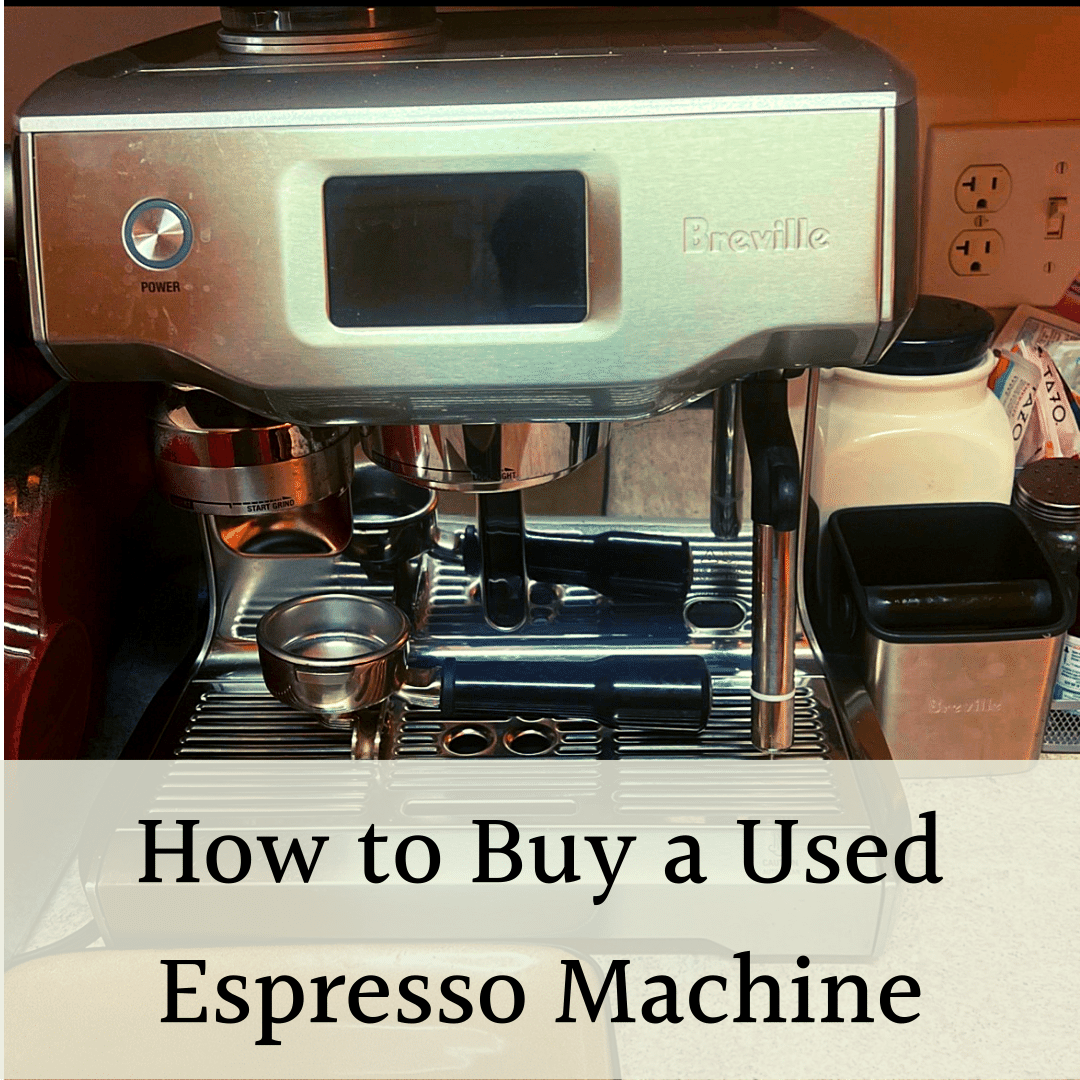For the past year, I’ve tested several automatic espresso machines — from DeLonghi to Jura — and decided to give Philips a try. I fell in love with the LatteGo system, its intuitive display, and easy maintenance. However, there were some aspects of the Philips 3200 I didn’t like, such as the flimsy milk container lid and weak espresso shots.
In my Philips 3200 LatteGo review, I’ll talk about all Philips 3200 series features. I’ll explain everything I liked, some design flaws I feel could be improved upon, and ways to get the most out of the machine. I’ll also provide alternatives and explain who this automatic espresso machine is best suited for.
Our Rating and Quick Overview
Philips 3200 LatteGo is a super-automatic machine. Do I recommend this machine? Yes! It’s a fully automatic espresso machine that won’t break the bank, is easy to maintain, and brews several espresso drinks.
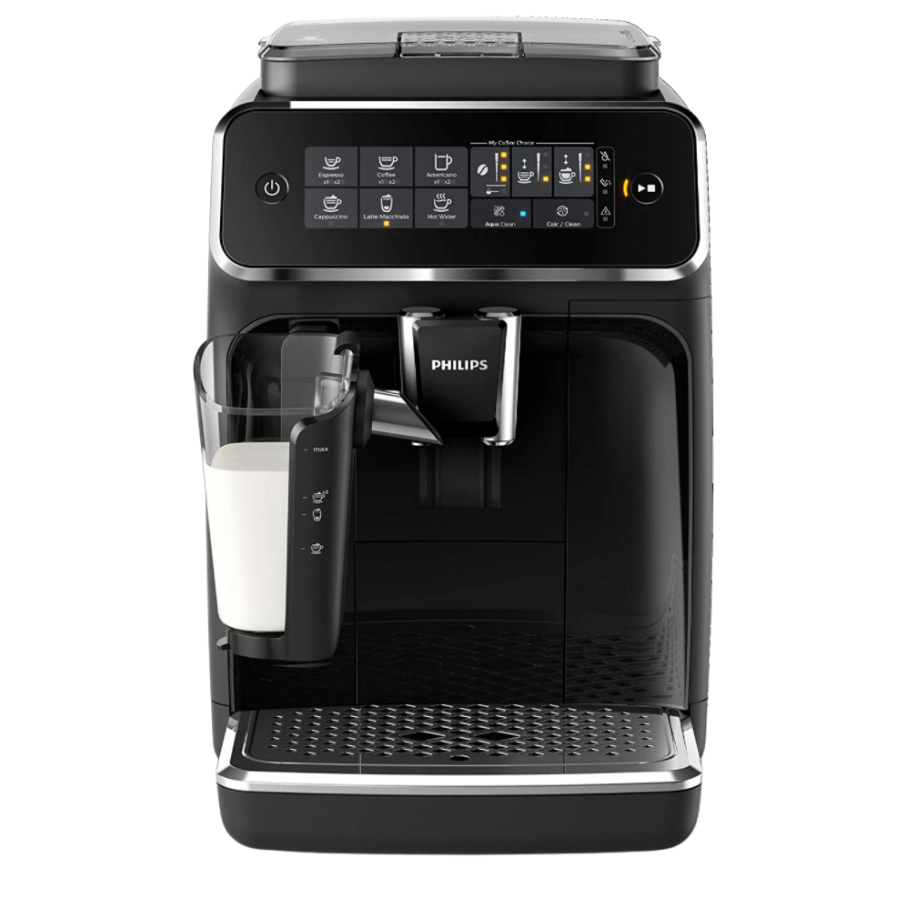
Philips 3200 LatteGo Features:
- Dimensions: 17 x 14.5 x 9.5 in
- Weight: 21.1 lbs
- Fully automatic milk frother
- Easy to clean and maintain: AquaClean water filter allows you to brew up to 5,000 cups before having to descale
- Brew five coffee beverages and hot water
- Intuitive Touch Display allows you to customize to your liking: aroma strength, coffee quantity, and milk froth
- Ceramic grinder with 12 settings
- Temperature: three different temperature settings
Philips 3200 has a fully automatic milk frother, so you’ll have milk foam and steamed milk at the press of a button.
It’s easy to clean and maintain thanks to removable elements located at the front and sides of the machine. Philips 3200 comes with an AquaClean filter that requires a descale after 5,000 cups. That means you won’t need to descale for about five years, even at three cups per day! You’ll struggle to find another machine in this range with this feature.
Finally, you can brew five different espresso drinks and dispense hot water. Additionally, you can customize settings for strength, volume, and milk froth.
Pros
The LatteGo system makes dense milk foam for cappuccinos and is very easy to clean.
Preprogrammed options for five drinks plus hot water
Easy maintenance with removable parts
AquaClean system only requires descaling after 5,000 cups
Cons
Espresso shots tend to be weak
Grinder and LatteGo system are loud
Drip tray fills quickly due to the initial rinse
Refresher On The Different Types Of Espresso Machines
Semi-automatic coffee machines give you more control over the espresso brewing process. You can choose how long you want to brew the espresso, the dose of ground coffee, and the volume of espresso out. Essentially, you have control over how the espresso will taste.
That said, there’s a lot more work: you have to grind, tamp, and load the portafilter. A semi-automatic requires practice to get right (and becomes a hobby for many users).
Super-automatic espresso machines (also called fully automatic or automatic) require less input from you. These machines have preset options, so all you need to do is load the coffee beans and press a button.
The machine brews your coffee beverages. If you want the machine to do the majority or all the work for you, go for a super-automatic espresso machine. However, semi-automatic machines can make a more nuanced drink, and tend to be cheaper.
The real tradeoff is how much work do you want to put into a semi-automatic for better output, compared to a higher price and ease with a super-automatic. The Philips 3200 balances a lot of these with high ease, quality, and reasonable price, which is why I like this machine.
Philips 3200 LatteGo Feature Detail
Here’s a full breakdown of all the Philips 3200 LatteGo features.
Design
Philips 3200 LatteGo has a modern design. This machine has a plastic build with chrome accents — the front panel has a stainless steel wrap.

It looks slightly blocky and is a little big at 17 x 14.5 x 9.5 in, and 21.1 pounds. It’s not too heavy to lift, but keep the depth in mind. That said, I was able to store it under my kitchen cabinet. The water tank is conveniently located in the front, on the right side of the machine. I liked that I didn’t have to pull out the espresso machine every time I wanted to refill the water tank.
The water tank holds 60 ounces and is conveniently located in the front, on the right side of the machine. I liked that I didn’t have to pull out the espresso machine every time I wanted to refill the water tank.
The bean hopper and grinder are located at the top. The hopper can hold a pound of beans.
Philips did a good job with the lid, which has a rubber seal and opaque color to stop air and sunlight when closed.

There is also a bypass doser for ground coffee. It is located in front of the Philips espresso machine bean hopper and is typically used if you want decaf when the hopper is full.
I really liked the display. Some buttons flash to let you know it’s time to refill the water tank, change the filter, or if some other error is occurring. More on that later.
One of my favorite design features is the adjustable coffee spout. I’ve used my fair share of coffee machines where my glass wouldn’t fit, or the spout is too short, and the drink splashes everywhere.
Philips 3200 has an adjustable spout, so I can lower and raise it depending on the type of beverage I am brewing. It can go from an espresso shot glass to a large mug, and I’m happy to report there are no splashes with this spout.
LatteGo Milk System
The LatteGo milk system is one of the major selling points for the Philips 3200 machine. The company even included it in the espresso machine name. The LatteGo is automatic, which means you get frothed milk with a push of a button.
The LatteGo system is a plastic container that you have to fill with milk and easily clip to the machine. When you choose the milk froth level, the frother mixes milk and air at high speed in the frothing chamber. Once it’s done, the machine dispenses a layer of milk foam into your cup.
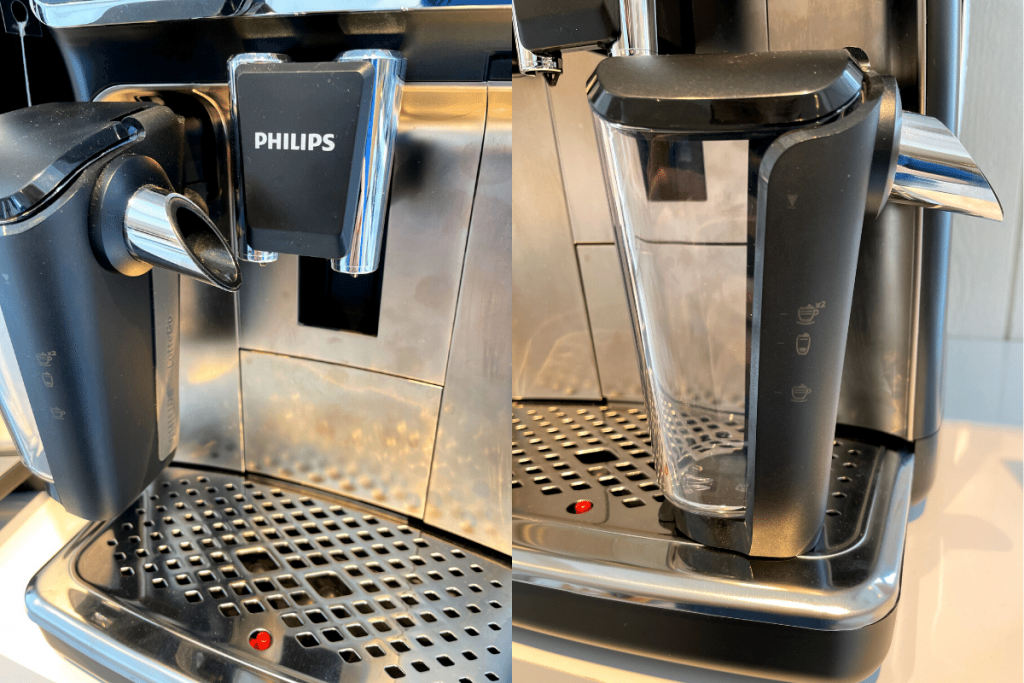
What stands out about LatteGo is its simplicity. It’s two pieces that clip together and easily attach to the machine. I like that the holder has notches that indicate how much milk you should pour and that there aren’t any tubes or other parts where milk can stagnate and spoil.
I admit that I’m guilty of not regularly cleaning steam wands, resulting in crusted milk inside. This doesn’t happen with Philips 3200 LatteGo. The container is completely detachable, and you can quickly rinse underwater.

Philips promises the machine will distribute the milk into your coffee cup without any splashes. This is true if you line up the mug with the milk dispenser. The first time I used it, I placed my mug too far back and was left with half the milk outside of my drink.
One thing I didn’t like about the LatteGo container was the lid. It rests on the milk container without a hinge to secure it, so it can be flimsy. I usually kept the milk container in the fridge and took it out when I wanted frothed milk, and knocked the lid off almost every time.
Another con of the LatteGo system is that it only creates very creamy and thick foam. No matter how much milk I used, I got consistent thick foam. That’s good for making a nice cappuccino.

However, the milk frother doesn’t create microfoam for milk-based drinks and, obviously, you can’t make latte art with the automatic function. You’ll need a manual steam wand to create a thinner foam, like on the Breville Barista or Breville Bambino models.
Espresso Quality
One downside of the Philips 3200 is the espresso tends to come out weak. You’ll notice shots have some crema, but not much. I’ve tried the same beans on the Philips and a semi-automatic and get somewhat watery espresso with Philips.
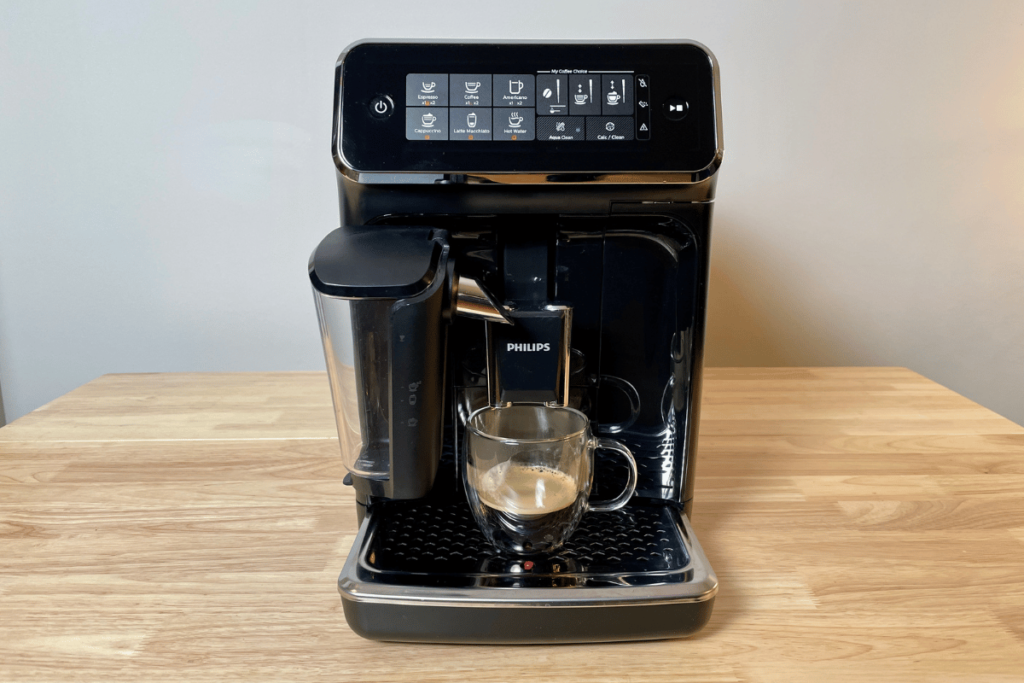
The problem is the espresso brews too quickly. Typically, espresso shots take 30 seconds, and Philips pulls a shot in 15 seconds. The culprit for this is the filter basket (what holds the coffee in the machine), which has large holes that allow the water to pass too quickly.
Most filter baskets have tiny holes that create resistance and lead to a full extraction of coffee oils, which is what makes espresso so bold and rich. You don’t quite get that with the Philips.

That said, I found three tips to improve your espresso dramatically:
- Use a finer grind size. I set the grinder to the 3-4 setting for best results (turn the knob counterclockwise in the hopper).
- Increase the water temperature. When the machine is turned off, hold the drink size button. Choose the high or max setting for better results.
- Increase the coffee strength. Importantly set the aroma strength option higher than the coffee volume for a higher ratio of coffee to water and a bolder flavor.
With those changes, your espresso will go from 50% of perfect to 80%. It still isn’t 100%, but that’s the trade-off for an automatic machine. The correct grind size and water temperature are really important to proper espresso, and the good thing is you can easily modify this with Philips.
One thing I liked about the Philips 3200 LatteGo is that the double shot is a true double shot, not a double long shot. The machine brews two separate espressos instead of using twice as much water for the same coffee. Most machines do the latter and burn the coffee.
Ceramic Grinder
Philips 3200 LatteGo has a ceramic flat burr grinder with 12 grind sizes. It’s not as granular as the Barista Pro, but you’ll be able to dial it in with coffee beans of varying coarseness. Philips says their ceramic grinder can brew up to 20,000 cups.
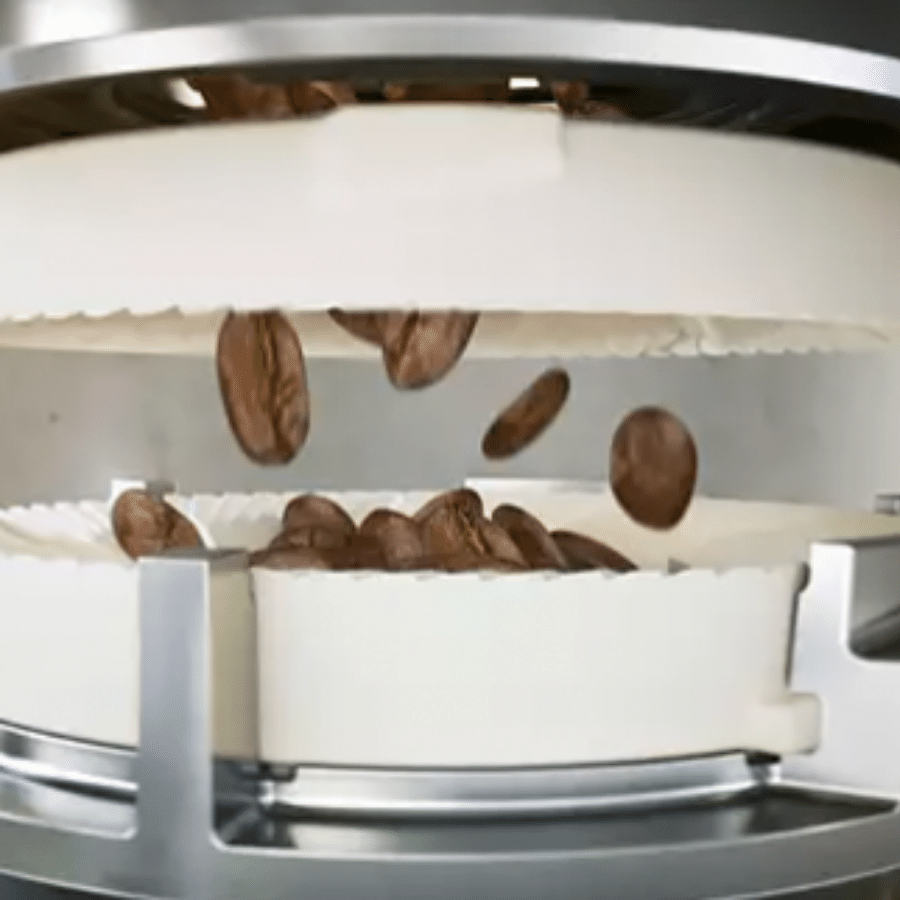
There is debate about flat vs. conical burr grinder users and ceramic vs. steel. Ceramic flat grinders have a better reputation and are found on much more expensive espresso machines.
The Philips 3200 series ceramic grinder is extremely precise and has 12 settings to dial-in the right grind size. Philips 3200 LatteGo gets major points for including a ceramic grinder in their automatic espresso machine.
Note: Only change the grind size when the machine is running, or you can jam the grinder. Philips also recommends not changing the grinder settings for the first 100 to 150 cups. I didn’t follow the latter rule without issue. Remember, turning the knob counterclockwise = finer, and clockwise = coarser.
One negative about the grinder: it’s loud. Flat burr grinders are typically loud, although this is noticeably louder than other super-automatic espresso machines. It’ll definitely give you a jolt in the morning when you’re making espresso.
Apart from grinding your own coffee beans, you can also use pre-ground coffee. A chute (or bypass doser) for pre-ground coffee is on top of the machine right in the middle by the main hopper.
Display Panel and Drink Options
Philips 3200 LatteGo has a front panel that lets you choose between five coffee drinks: espresso, cappuccino, latte macchiato, Americano, and black coffee. Technically, Philips says six drinks because you can draw hot water from the LatteGo system.
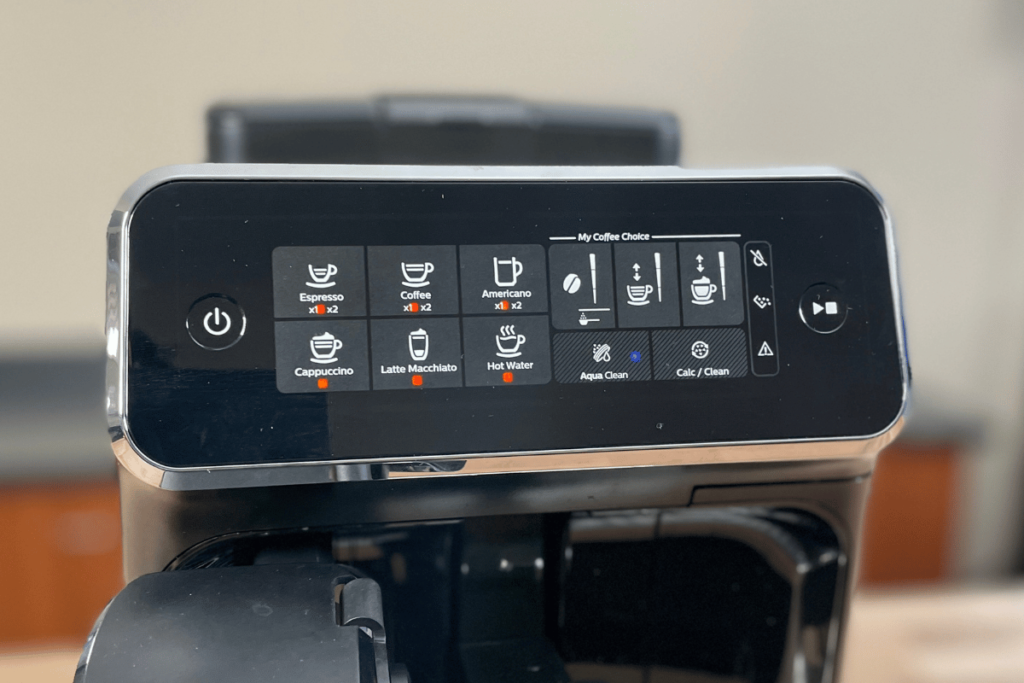
The panel is as intuitive as it looks, and you can also brew a double size of espresso, Americano, or regular coffee from the front panel as well. The Philips 3200 brews two drinks, one after the other.
You can customize drinks for strength, volume, and milk froth. I like the three settings for each of these because espresso is a nuanced drink and you want to get the right setting for your beans and palate. As I said, I recommend making ristrettos with a higher coffee-to-water ratio by choosing a bigger strength than volume.
AquaClean Filter
Philips 3200 LatteGo coffee maker comes with an AquaClean filter. According to the company, you won’t need to descale the machine for about 5,000 cups. This means you’ll be able to brew several coffee beverages daily and only have to descale the machine every five years or so.
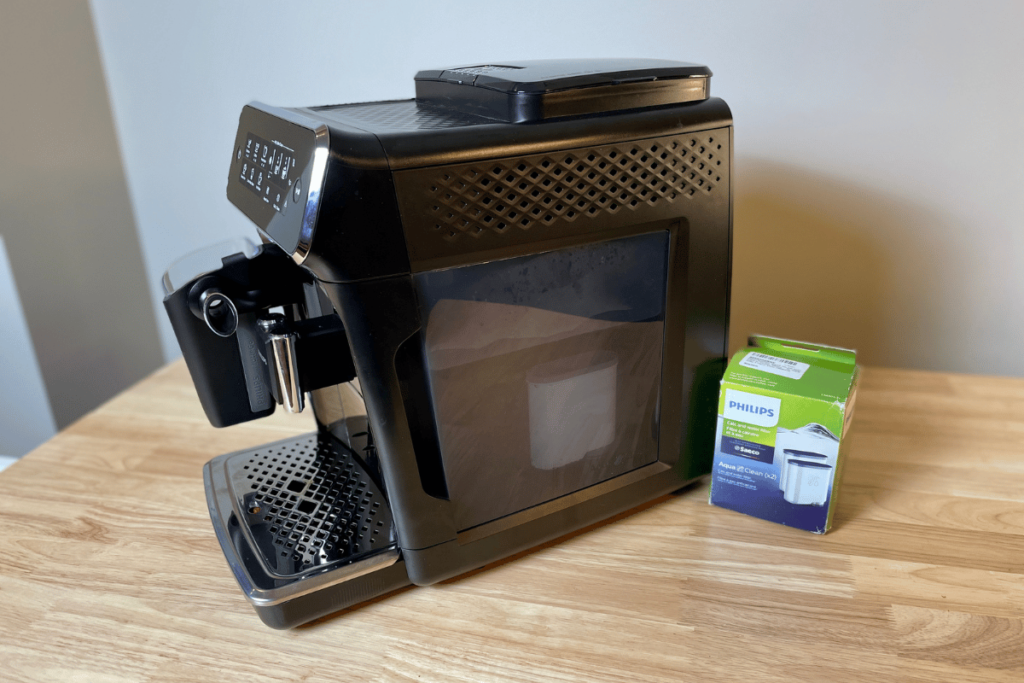
The catch is you have to replace the AquaClean filter every 50 tanks, or about every three months. You’ll know it’s time to replace the filter when the filter light changes from blue to flashing orange.
Overall, the AquaClean system is extremely convenient and another big plus for Philips 3200 LatteGo. Most espresso machines need a substantial descale every few months or the machine won’t operate.
Temperature Control
Philips 3200 LatteGo has three temperature settings, which means you can change how hot your coffee is.
This option is a little hidden but it’s really important for improving your espresso. To make it easier for you, here’s how to change the temperature:
- Press the on/off button to turn off the machine
- Press and hold the coffee quantity button when the Philips 3200 LatteGo is switched off.
- Press the icon and select normal, high, or max temperature when the lights are up.
- Press the stop/start button
- Press the on/off button to turn the machine back on
Philips 3200 LatteGo Setup
You’ll need a few hours and the manual to set up the Philips 3200 LatteGo. I turned to Philips YouTube videos, as the manual was very photo-heavy. Luckily, once you get used to using the machine, it’s pretty intuitive.
The first steps include rinsing the machine, activating the AquaClean filter, and testing the water hardness. You can use a test strip to determine water hardness and input your results. How hard your water is will determine how often you’ll have to descale (harder water = more frequent descale), but the AquaClean filter makes it very infrequent.
When you start the machine, it takes two minutes to warm up. The machine will do an automatic rinsing cycle. You’ll know it’s ready for use when all drink icons are lit up.
Cleaning and Maintenance
Philips 3200 LatteGo is easy to clean as it has a lot of detachable parts:
- Brew head — Removable brew group is accessed via a door at the back of the water tank. Rinse once a week to remove excess grounds.
- Drip tray — The drip tray has a shut-off that tells you it’s time to empty it. However, by the time the shut-off is activated, the tray is very full. I regularly spilled water when removing it, so I recommended not waiting for the full indication but emptying it regularly.
- Used coffee grounds container — Pulls out together with the drip tray and can hold 12 servings.
- Water tank — Front-loading water tank is easier to refill and replace the water filter.
- LatteGo milk system — It’s just two parts -container and lid – and can be rinsed under water after each use.
Overall, Philips 3200 LatteGo is extremely easy to clean. A lot of its parts, such as the drip tray, LatteGo milk system, and the coffee grounds container, are also dishwasher safe.

The exterior is easy to maintain as well. Just wipe it with a wet cloth.
You’ll have to do some maintenance to keep the machine running well. You should apply lubrication to the brew unit every two months. I liked that Philips provides a grease tube with 3200 LatteGo, so you get everything you need.
Value And Recommendation
Considering Philips 3200 LatteGo is a super-automatic espresso machine, it’s affordable. Other super-automatic models go for two and three times the cost.
I think this is a great value if you go to the coffee shop for a daily latte and/or cappuccino. Philips makes great milk drinks with ease and very little maintenance, which is a big plus.
If you want the absolute richest espresso out there, there are better options, as the espresso itself is a little weak.
Overall, it’s a good investment that will deliver decent coffee for years to come. Plus, you’ll save money as you won’t have to run to the coffee shop daily for your caffeine fix.
Philips Espresso Machine Comparison
Philips has a line of espresso machines, where the functionality increases with the number. The main difference between models is the number of drink options and display quality. The milk frothing system, heating element, and grinder are the same, and you can usually find models with and without the LatteGo system.
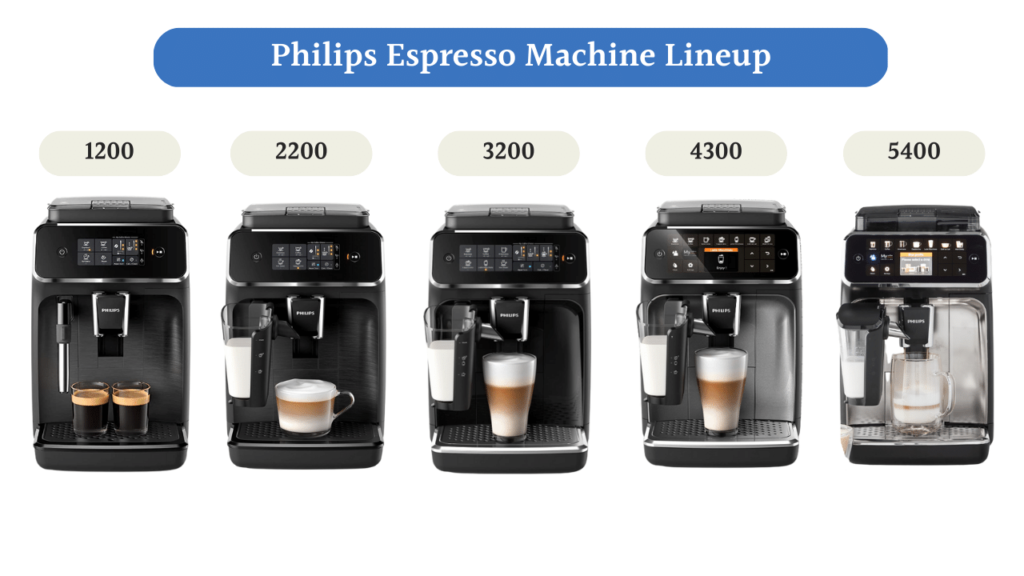
Personally, I like the Philips 3200 and 4300 the most, because you get the latte macchiato option and the ability to customize the milk level too. The 4300 is a nice step up with extra drink options and a better intuitive display. We’ve also written about the high-end Philips 5400 with a more detailed comparison table in that article here.
Philips 3200 LatteGo: Final Thoughts
Philips 3200 is an excellent machine for brewing coffee. You’ll consistently get good quality espresso and four other drinks: Americano, latte macchiato, cappuccino, and coffee.

Bottom line: The Philips 3200 LatteGo is a perfect starter super-automatic espresso machine.
- Five espresso drink options with a bright-lit display
- Options for temperature, aroma, coffee quantity, and milk froth
- LatteGo milk frother makes one-touch cappuccinos
- AquaClean system requires descaling after 5,000 drinks
- High-quality flat, ceramic burr grinder
It’s extremely easy to clean, thanks to the removable brew head and other removable parts located at the front. You can rinse them underwater or use your dishwasher. The LatteGo system will froth your milk with a touch of a button, and AquaClean will keep your machine going for years without having to stop the brewing to descale.
But, if you’d like a coffee machine that allows you to grow your barista skills, have more control over the brewing process, and create latte art, check out our Breville Barista Pro Review.

